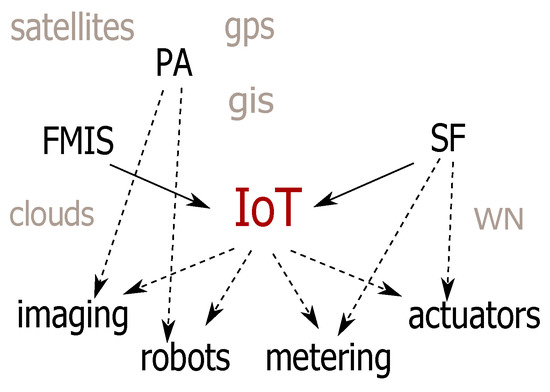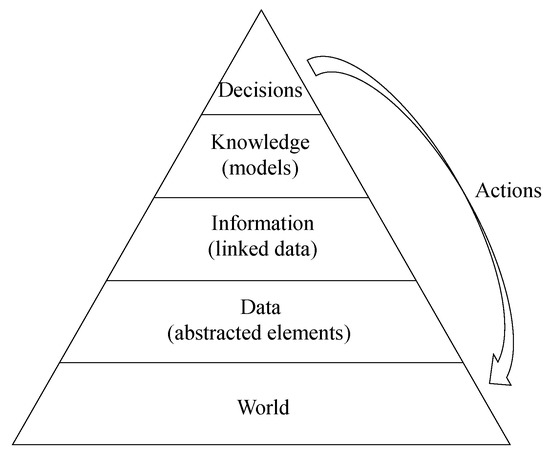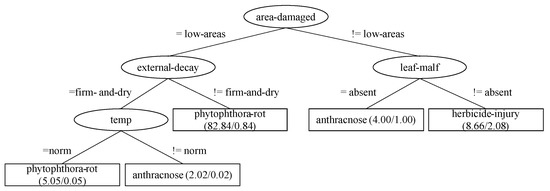1000/1000
Hot
Most Recent

IoT is becoming a bearing technology for next generation crop management. Cheap networked devices can sense crop fields at a finer grain to give timeliness warnings on the presence of stress conditions and diseases, while on-board devices will monitor field and machine status. Cloud computing allows integrating collected information in a new generation of FMIS to make decisions and automate field practices by actuators and robot fleets.
Though agriculture is recognized as a fundamental activity for all activities of mankind[1], it has had difficulties in accessing technology until the Green Revolution (GR), which led it to a (irreversible) new concept of agriculture. Machinery and chemicals were brought to agriculture to face environmental and sustainability problems, and other injections of technology have been claimed to solve them. Advances in remote sensing and Information and Communication Technologies (ICT) fostered Precision Agriculture (PA), relying on satellite-based geo-referencing, remote sensing, and imagery for surfaces survey and variable-rate applications, recently operated by autonomous vehicles[2][3]. Computers began to appear in farmers’ everyday lives to host Farm Management Information Systems (FMIS)[4][5] formerly entailing administrative, accountancy, and warehouse management tools. FMISs of the last generation include the Geographical Information System[6] and Decision Support Tools (DST[7][8]). The latter is often based on Cropping System Simulators (CSS), born for learning purposes and later used for irrigation scheduling [9], hydrologic watershed management[10], and pest[11] and disease prediction[12]. The Internet, whose impacts on agriculture was envisaged more than twenty years ago[13], allowed FMISs to become outsourced services (e.g., for irrigation service managed by farmers associations) that profited from the growing amount of networked information (e.g., weather networks). The diffusion of Wireless Networks led to a number of applications recollected under the name of Smart Farming (SF)[3], centered on distributed Wireless Sensor Networks (WSNs) of sensors and actuators [14]. Major applications of SF are in high-value cropping systems such as greenhouse crops and vineyards[15]. Smart Agriculture (SA) extended the concepts behind SF to every actor of the agri-food supply-chain and their stakeholders[16]. Cloud Computing raised former problems of data ownership and employed leading software producers to follow different policies. Recently, the awareness of the added value of data redundancy and data-exchange in problem solving has grown[17]. Cloud Computing already signed the beginning of a new age[18] and of the birth of the Internet of Things (IoT).
The first definition of IoT can be credited to Ashton et al.[19], who defined it as “an open and comprehensive network of intelligent objects that have the capacity to auto-organize, share information, data and resources, reacting and acting in face of situations and changes in the environment”. Such “intelligent objects”, later called “things”, refer to every physical and/or software devices that are identifiable and connected to a network with processing, sensing, and acting capabilities[20][21]. During the last two decades, IoT has become a consolidated reality consisting of a collection network of devices connected in a dynamic (and commonly asynchronous) environment, enabling the possibility to provide a massive amount of information to feed machine learning algorithms and may also react proactively to environmental stimuli operating on actuators aimed at minimizing human involvement [22]. IoT is invading every sector of everyday life and, despite the belief that it is just at the beginning of Gartner’s IT development curve[23], IoT has already been adopted by a considerable number of USA farms[5]. A recent analysis [24]estimated that in 2027, the sector will be worth 34 billion USD, with an expected increase in productivity of up to 70% by 2050[25]. IoT is the technology characterizing Agriculture 5.0 (Figure 1).

Figure 1. Major recent technologies involved in Agriculture 5.0. IoT—Internet of Things; PA—Precision Agriculture; FMIS—Farm Management Information Systems; WN—Wireless Networks; SF—Smart Farming; gis—geographic information systems; GPS—Global Positioning System.
Cropping systems are characterized by ecological, economic, and social aspects, and a farmer needs to keep all of them under control. Though recently policies, labor, and market are relevant aspects, ecological control represents the dominant tasks of a farmer, and it is pursued in different stages. In the setup phase of a production system, control means choosing a cropping technology, a long-term decision determined from landscape (e.g., terrace cultivation), climate (e.g., rain-fed crops), social aspects, resource availability, and market organization, the combination of which generated a multitude of different scenarios[3].
In the management practices of everyday cropping systems, adopted technologies determine relevant differences in the ability to control the environment. The main difference in cropping systems can be identified between indoor and outdoor, investigated by Navarro et al.[26]. In indoor systems, almost all production factors are under control: relevant environmental variables are regulated by hydro-electro-mechanical systems that timely supply the proper lighting, openings, fans, water, and nutrients. Only partial control can be performed in tunnels (temperature and humidity are conditioned by openings) and nets (used to prevent the spreading of insects, bird flights, and hail). In field crops, chances to control environmental factors are less available. Farmers are often unarmed in front of weather, pests, and diseases.
All of the actions mentioned—planning, scheduling, decision, and control—are based on direct and indirect continuous observations[27] of each factor affecting production. Here, we recall the most important ones.
Weather—Stations are present even in many non-experimental farms. The classical outfit is that of a climatic station: rain-gauge, temperature, and relative humidity. In the 1970s, pan evaporimeter was also added in agro-weather stations, while radiation, wind velocity/direction, and leaf wetness became more frequent from the 1980s with the diffusion of electronic stations. Less frequent is the availability of soil temperature.
Water availability—Water is recognized as the most important production factor (e.g., GRIDA[28]); in dry-summer regions (Mediterranean areas) rainfall trends determine huge risks in growing a crop, as prolonged drought in conjunction with high temperatures in a sensitive period (e.g., seedling, flowering) have dramatic effects on yield. As water availability is not always an option, it has a main role in crop choice (e.g., irrigated vs. rain-fed) and checking soil availability in terms of water content (e.g., [29]) or soil water potential (e.g.,[30]), or directly by direct observation of plant status (IR sensors); water excess scenarios are no less dangerous to a crop: rainfall of long duration or high intensity, as much as an unexpected hail can do no less damage to a crop (as they do to humans); drainage systems, relevant to hydrological network management, together with channel, storage, and distribution systems, become really important for water supply.
Fertility—Nutritive substances are essential for plant growth, and in many cases fertilizer is applied along the growing season (e.g., foliage fertilizer); soil water sensors often include electric conductivity, used to deduct information on soil nutrient contents. More reliable information on the nutritional state of a crop can be obtained from multispectral and hyperspectral camera sensors set on field cameras.
Pests and diseases—Detecting the presence and development stage of pests and disease, spreading of insects and weeds is fundamental in growing a single species. A main activity of every farmer is maintaining an artificial ecosystem and preventing its shift toward a community of species that deteriorate the quality and quantity of expected yield. Specific sensors are available to the purpose and are already used in agro-weather networks as leaf wetness.
Other production-related aspects—Detectors for carbon dioxide and other gases (IRGA) are used (mostly for research purposes) to monitor plant and soil respiration rates, including GHG emissions; IR sensors are also used for detecting heat anomalies (we already mentioned water stress) as the presence of flames and intrusions (PIR) from hot blood animals, eventually integrated with cameras. Increasing is the interest in canopy monitoring by multipurpose cameras with sensors of variable sensitivity.
Transponders—Machines have a particular role in control. They are a part of technology and a production factor; they need to be controlled to be in a good working state, and under constant survey in the case of autonomous vehicles because of dangers and damages that failures may represent for human beings, crops, and the environment. Moreover, vehicles may host sensors for self-monitoring[31], and fields from varying distances (UAVs), allowing the increase of spatial detail and time resolution of most sensing tasks listed above.
Observations are used in production systems following the expected model and known application schemes.
Scientific knowledge has been used to build Cropping System Simulators (CSS) based on physical and empirical modules, with a different conceptualization and operational level[32]. Those with a hydrological component are also used to simulate floods, erosion, and chemical leaching. Several of these models are already embedded in automatic control (e.g., irrigation) operating as a common “home-thermostat”, and the same is also true for crop growth, and pest and disease forecast, this time using growing degree day and cardinal temperatures as thresholds for growth rate of populations during each phenology stage. CSSs are used for planning land-use, selecting crop rotations, or to forecast the spreading of pests and diseases, to produce bulletins/alerts of extension services. However, they often require a lot of parameters from expensive calibrations to be applied to a specific context, and require additional modules and algorithm refinement. Further, to be used as DSTs, simulators produce indicators and indices to be interpreted as criteria around the objectives with strong subjective (stakeholder dependent) weights, while the final decision always includes a risk component even more difficult to be estimated[33].
That is the reason why empirical knowledge is still largely used. Adopted cropping systems are mostly based on recipes refined from experience. A proof is given from the interest in “Crowd sourcing” which has been recognized as one of the most effective sources of knowledge, e.g., to collect and make growing techniques available to other farmers[34].
Machine learning (ML) methodologies are expected to accelerate the production of DSTs, by means of a class of methods recollected in the “prescriptive-analytics”[35]. ML processes data in the same way humans do in knowledge enhancement, a process abstracted in the “knowledge pyramid” (Figure 5), a metaphor that represents—starting from a large amount of raw data that individually have a limited information value—the synthesis of insights with a progressively higher value.

Figure 5. The “knowledge pyramid” (adapted from[36]). Actions affect the “World” level.
Machine learning (ML), relying on many families of algorithms among which (deep) neural networks[37] have recently become the most hyped, can simulate such a climbing process. Of wide interest in PA applications (e.g., for species recognition[38]), ML is based on a training phase, whose effectiveness can depend on the amount of data at hand. For instance, deep neural networks tune millions (or more) parameters (i.e., the weight of each neural connection); as a consequence, the bigger the data set, the better the networks learn. This is why the terms big data and ML are often confused; big data and huge computational capability—which can be accessed on-demand through cloud computing—are the enabling factors for ML. However, there are trade-offs between quality and quantity of data; high-quality small data can produce better inferences than low-quality big data[39]. Big data can have poor informative content, this is the reason why the correct design of a data warehouse, a repository that integrates data to make them accessible for successive stages[40], is a fundamental step.
At present, most of the knowledge produced by ML is “hidden” in a matrix of empirical values and cannot be expressed in terms of a physical (dynamical) model. Nonetheless, XAI (eXplainable Artificial Intelligence), aimed at producing explainable and comprehensible models, is becoming of increasing interest also in the domain of Machine Learning[41], proving that extracting “something coherent and valuable” from numbers or images is still the main task [5]. Figure 6 represents a decision tree, an explainable model made of human-friendly rules[42], which emerged from an ML analysis of features of soybean seeds related to different diseases (data set from[43]).

Figure 6. Excerpt of a decision tree for soybean seed disease identification.
From the literature, IoT technology appears to be applied in a number of pilot applications[44][45][46] or dealing with research projects bearing on prototypes designed from developer-oriented boards[45] and using public cloud computing services[47].
In some cases, Smart Farming and Robotization are already part of IoT systems. Greenhouse control systems are integrated with the Internet and control actuated by Cloud-based Intelligent Systems[3]. Robots and other UVs adopt communication protocols typical of IoT systems such as ROS (derived from DDS) and allow them to be part of the IoT ecosystem[48].
Sensor data can be accessed from everywhere, including those aboard field machinery to trace their activities [44][49], adding details to crop management and yield[50] to produce data useful to cropping system simulators and produce accurate costing and financial reports; for instance, allowing for an appropriate allocation of indirect and general cost to a specific crop or activity[51].
The IoT produces information to be used beyond the boundaries of farms, to help farmers manage the relationships with the downstream tiers of the supply chain, allowing them to fit the harvesting period to market demand.
Crop management details are of high interest for many stakeholders, including agricultural cooperatives and quality certification bodies. Arena et al. [52] describe how IoT data from interconnected sensors may rely upon a blockchain-based application for traceability and certification.
Social aspects are expected to have benefits too, from the development of an informed and connected rural community[53] useful for problem solving: disease alert, pest identification, labor demand/offer.
A methodological survey[53] identifies 4 mayor areas of applications of IoT in agriculture:
Monitoring environment (air, soil, water), crops (plant), and animals—62%;
Remote control in irrigation, fertilization, pesticides, lighting, intrusions—25% of papers;
Prediction of environmental conditions, production, growth—6% of papers;
Logistics—7% of papers.
Table 4. Major activities involving IoT technology.
| Task | ||
|---|---|---|
| Services | Know-how support/education | [43][54] |
| DSS/Crop Models | [55][56][57][58][59] | |
| FMIS/accountability | [4][5][51] | |
| FMIS/PA/machine activity/resource usage | [49][50] | |
| Market | quality/certification/traceability | [7][51] |
| seeds/products/machinery/labour | [46][54] | |
| Crop monitoring | environmental sensing | [3][44][26][53] |
| detect crop stress/diseases/pests/weeds/ripening | [46][55][60][61] | |
| Crop practices | smart farming/remote control/automation | [2][62][44][48][63][64][65] |
| precision practices/prescription maps | [5][44][49] |
< section omitted - see full article on Agronomy 2021, 11, 181>
We finally may answer the foremost questions set above. IoT is going to improve crop management in terms of accessibility due to the reduction of costs and efficiency due tothe timeliness of interventions, and IoT is increasingly offering solutions to crop manage-ment problems, most of which are yet unsolved, by the means of AI-driven “prescriptiveanalytics” implemented in CC systems.In fact, from the literature analysis, IoT appears as a set of enabling technologies,allowing for a vast combination of architectures (e.g., [44]) and acting as a glue betweenFMISs, Smart Farming, and Precision Farming.IoT has yet a little role in the choice and design of a cropping system, which is limitedto experienced reliable recipes and farmers’ focus on control.IoT technology is making crop monitoring, crop data analysis, and automated con-trol more accessible than ever, and wide adoption of IoT is expected where there is arequirement for refinement of observations, prescriptions, timeliness of intervention, andoptimization of resources (machinery, pesticides, water, etc.).At present, the following points can be emphasized.• IoT is an enabling and mature technology, proven to be able to accelerate the adoptionof SF.• Relying on IoT, many solutions to Smart Farming and Farm Management Systems aregoing to be accessible even to small farm holders.• IoT allows increasing access to crop monitoring and significantly enhances the avail-ability of information and early warnings which, in turn, provide more reliablepredictions and decision-making support to farmers, managers, and policymakers.
• IoT is based on easy-access technology, facilitating its adoption, which is limited from financial resources[66]. Furthermore, IoT will influence the market and accelerating the development of low-cost next-generation Precision Farming[65]. Critical steps in the IoT adoption should also be evidenced.
• Excitement in IoT is pumping the belief that a large number of cheap sensors could increase data granularity in space and time with an acceptable decrease in data quality. However, data (sensor) reliability remains a fundamental aspect of any technology.
• ML is, to date, too focused on solving problems, underestimating the data requirement for learning stage and the need for explainable knowledge oriented to enhance models for simulation of bio-agro-ecological, soil-plant-atmosphere, and value-chain systems.
• Ethical aspects also emerge. Industrialization and spreading of micro-IoT-devices, en-visaging fleets of “artificial insects”, could require strong regulations,[67] including a protocol for placement, location, and recollection.
Finally, the digital divide is still observed to be a concern[59][68], which also affects cropping system technology and production efficiency. IoT can facilitate both exogenous barriers, encouraging the spread of infrastructure[69], and endogenous ones. IoT may help to change the mindset of many farmers, allowing them to easily access the available
solutions[70]and share knowledge on cropping systems[71].